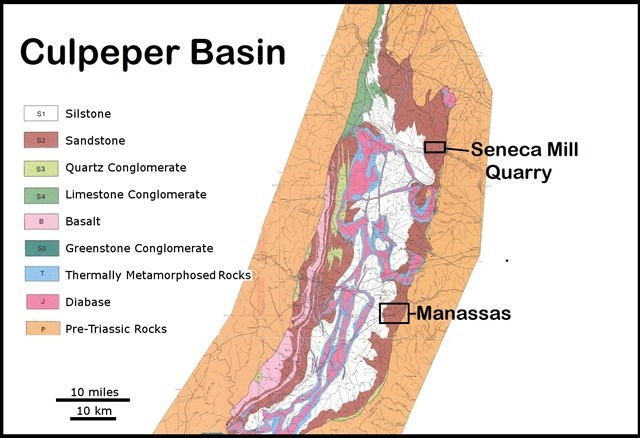This is an Earthcache – as such, there is no physical cache. Instead you will partake in a geology lesson by making observations and answering 4 questions about the Manassas Sandstone at the Manassas Industrial School & Jennie Dean Memorial. Permission for this listing has been granted by Manassas City Parks. No night caching allowed.

These red, gray, and yellow sandstone benches are made of a local rock named Manassas Sandstone. Triassic sandstone is assigned to the Culpeper Group overlies older crystalline rocks of the Reston Formation, and underlies the shales of the Bull Run formation.
Millions of years ago when the plates that formed the super continent Pangea pulled apart, the crust in the middle of massive land mass was stretched and spread out. Basins like the Culpeper Formation formed and then sank. Milllions of years erosion deposited up to 20,000-25,000 feet of sand and silt into the basin. The sandstones created from those sediments are known as "red beds" due to the oxidized iron or rust that coats the sand grains.
The Culpeper Basin extends from New Jersey to central Virginia. The sediments that formed the red bedrock material existing in this basin were deposited during the late Triassic Period. These sedimentary rocks are predominantly siltstones, but include shales, sandstones, and conglomerates. Alluvial deposits of gravel, cobbles, sandstone boulders, and weathered igneous rocks exist along stream terraces. This includes other rock types from outside the Basin that was transported downstream by an ancient Potomac River.

Manassas Red Sandstone was originally deposited as a more typical light-colored quartz sandstone. Though, instead of being deposited in the ocean like other sandstones (such as Aquia Sandstone), red sandstone was deposited on the land in an arid environment in a river deposit or dune. For a millennia it sat there exposed to atmosphere and weathering. Over time small quantities of iron-rich minerals infiltrated the stone and oxidized the iron into hematite crystals (Fe2O3). These crystals coated its quartz grains which allows them to absorb all of the stones lighter colors, except for red. The crystals reflect the red and give this sandstone it’s red color.

A coarser, reddish-brown sandstone from the east margin of the basin, near Seneca, Md., was quarried as building stone for the C&O Canal and the Smithsonian Institution's Castle. The builders of the Smithsonian Castle never intended it to be red, as the stone was a "warm gray" when installed.
LOGGING REQUIREMENTS:
To log this Earthcache: Read the geology lesson above. Answer all four questions posted below and send them via e-mail or messenger contacts on my Geocaching profile.
QUESTION 1. What did oxidation and iron rich minerals do to this sandstone?
QUESTION 2. Touch the stone. Does it have soft "sandy" texture, or is it very hard and smooth?
QUESTION 3. Can you clearly see the sedimentary layers?
QUESTION 4. Find patched of dirt nearby where grass is not growing. Do the dirt sediments there match the color of the sandstone? Why do you think that is?
OPTIONAL PHOTO: Posting a photo that readily indicates that you (and anyone else logging the find) are at the location.
 Awesnap has earned GSA's highest level:
Awesnap has earned GSA's highest level:

 Best Earthcache
Best Earthcache
REFERENCES:
1. The Culpeper Basin, William C. Burton, The Culpeper Basin: In the northern Piedmont Region of Virginia, website, Januray 2, 2015, culpepperconnections.com
2. Triassic Basins in Virginia, website, virginiaplaces.org
3. Triassic- Jurassic Stratigraphy of the Culpeper and Barboursville Basins, Virginia and Maryland, By K.Y. LEE and AJ. FROELICH, U.S. Geological Survey Proffesional Paper 1472, 1989, pubs.usgs.gov
4. Culpeper Basin, website, wikipedia.org
5. What Makes Sandstone Red?, website, selectstone.com